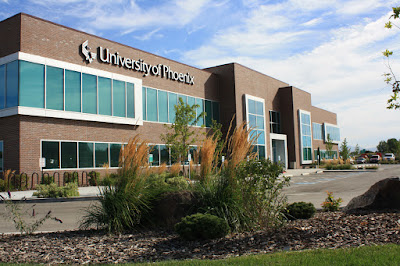INTRODUCTION
The University of Phoenix (UOPX) is an American for-profit institution of higher learning, headquartered in Phoenix, Arizona, United States. This university has an open-enrollment admission policy,requiring a GED, high-school diploma, or its substitute as its criterion for admissions. The university has 91 campuses worldwide and confers degrees in more than hundred degree programs at the associate, bachelor's, master's and doctoral degree levels. It is a wholly owned collateral of Apollo Education Group Inc., a publicly traded (NASDAQ: APOL) Phoenix-based corporation that owns several for-profit educational institutions.
The university was founded by John Sperling. Started in 1976, the first class comprised of 8 students. In 1980, the school expanded to San Jose, California, and in 1989, the university launched its online program.
Campuses

While the school specializes in online programs, the campuses offer supplementary programs and services. Online candidates are also able to use tutoring and social centers, which can be used for student social and meetings. The 1st center opened in 2007 in Plano, Texas.
Students also have access to subject-specific online resources, which include an electronic library, textbooks, and other ancillary material essential for a course. The university says that the electronic textbooks include search features and hyperlinks to glossary terms which make the books easier to use for research.
In 2016 the University of Phoenix indicated plans to shrink from ninety- one campuses and learning centers to sixty - seven.

ACADEMICS
The university offers degree programs through these schools and colleges College of Education, College of Health Professions, School of Advanced Studies, School of Health Services Administration, School of Business, College of Information Systems and Technology, College of Security and Criminal Justice, College of Humanities and Sciences
, College of Social Sciences, School of Nursing, etc.
In addition to its cultural education programs, the school also offers continuing education courses for teachers and practitioners, professional development courses for the companies, and also specialized courses of study for military personnel.
Students spend 20 to 24 hours with an instructor during every course, in comparision with about 40 hours at a traditional university. The university demands students to collaborate by working during the learning team projects, where in the class is divided into learning teams of 4 to 5 students. Each and every learning team is assigned a team forum where team members discuss the project and deliver their agreed upon portions of the team assignment for compilation by the nominated learning team leader.
Through its online platform( eCampus) students also have access to software required for coursework. Students have access to the virtual companies formed by the university to provide students with assignments, which Adam Honea, UOPX's dean and provost claims are much more practical and realistic than those available with case studies.[23] In August 2011, Apollo group announced that it would buy hundred percent of Carnegie Learning to advance its efforts to incorporate adaptive learning into its academic platform.
Some faculties and former students argue with the abbreviated courses and the use of learning teams resulting in an inferior education. The University of Phoenix has been criticized for lack of academic rigor. Henry M. Levin, a professor of higher education at Teachers College at Columbia University, called its business degree an "MBA Lite", saying "I have viewed the course materials. It's a very low level of instruction."

Students
The University of Phoenix reached a peak enrollment of almost 600,000 students in 2010, but its numbers have declined to about 162,000 as of 2016. Many different reasons have been given for the enrollment drop (and more than 100 campus closings). An article which was attributed in the Wall Street Journal explained the drop to operational changes amid criticism of high debt loads and very less job prospects for students of profit colleges, while an article in Buzzfeed attributed it to operational refinement inclusive of the implementation of student orientation, a free three week trial period and a new entrance exam.
The average age of an undergraduate student at University of is 33. The average graduate student is 36. In the year 2007- 2008 the university declared that nearly 2/3 of its students were women and that a plurality of students who were attending the school studied business (undergraduate students representing 29.9% and graduate students 12.9%), followed side by side by those attending in Axia College for associate degrees (28.1%).
The university graduates the largest number of under-represented students with master's degrees in business, health care, and education of any U.S. school.[97][98]
In the year 2013, the United States Department of Defense closed its contract with University of Phoenix for military bases in Europe.
Faculty
The university depends heavily on contingent faculty: 95 percent of Phoenix instructors teach part-time, compared to an average of 47% throughout the nation. This reliance on part-time faculty has been criticized by regulators and academic judges. Most of the classrooms are centrally crafted and standardized to ensure consistency and to maximize profits. Additionally, none of the faculty members get tenure.
According to a university officer, pre-screened instructional candidates engage in a training program under the discipline in which they teach, which has the effect of weeding out 40% to 50% of the "none-committed" or incapable applicants.
African-Americans make up 18.6% of the university's total of 22,000 faculty members, and 5.6% are Latino Women make up 57% of the faculty.
Adjuncts make approximately $1000–$2000 per course.


No comments:
Post a Comment